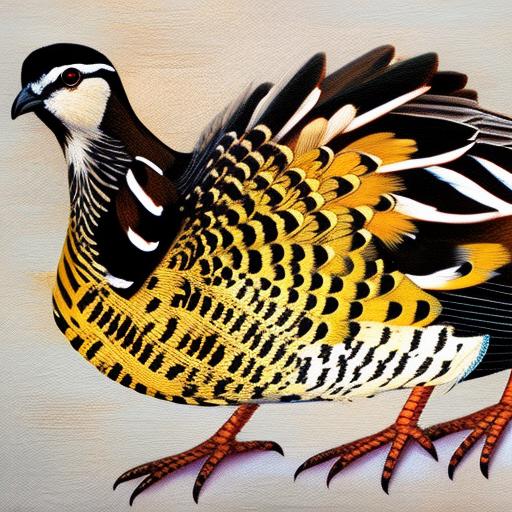Tuxedo quail, also known as Pharaoh quail, are a popular breed of quail that are often bred for their attractive plumage and delicious meat. They are a small, hardy bird that is relatively easy to care for, making them an ideal choice for beginner breeders. Tuxedo quail come in a variety of colors, including black, brown, and white, and are known for their distinctive markings, which resemble a tuxedo. Breeding Tuxedo quail can be a rewarding and profitable venture for those who are interested in raising these beautiful birds.
Breeding Tuxedo quail requires careful attention to detail and a good understanding of their specific needs. From selecting breeding stock to caring for chicks and young quail, there are many factors to consider when embarking on a Tuxedo quail breeding program. In this article, we will explore the various aspects of breeding Tuxedo quail, including selecting breeding stock, housing and care, the breeding and incubation process, caring for chicks and young quail, health and nutrition, and selling and marketing Tuxedo quail offspring. By the end of this article, you will have a comprehensive understanding of what it takes to successfully breed Tuxedo quail.
Key Takeaways
- Tuxedo quail breeding is a rewarding hobby that requires careful selection of breeding stock and proper housing and care.
- When selecting breeding stock, look for healthy, active birds with good coloration and markings to ensure strong offspring.
- Provide breeding tuxedo quail with a spacious and clean housing environment, along with a balanced diet and regular access to fresh water.
- The breeding and incubation process involves setting up a suitable nesting area and carefully monitoring the eggs for signs of development.
- Caring for chicks and young quail involves providing a warm and safe brooding area, along with a high-protein diet to support their growth and development.
Selecting Breeding Stock
Selecting the right breeding stock is crucial to the success of any breeding program. When it comes to Tuxedo quail, it is important to choose birds that are healthy, well-maintained, and have desirable traits such as good plumage and strong genetics. Look for birds that are active, alert, and free from any signs of illness or deformities. It is also important to consider the age of the birds, as younger birds are generally more fertile and have a longer breeding lifespan.
When selecting breeding stock, it is also important to consider the genetic diversity of the birds. Inbreeding can lead to genetic defects and health problems in the offspring, so it is important to choose birds from different bloodlines to ensure genetic diversity. Additionally, consider the color and markings of the birds, as these traits will be passed down to the offspring. If you are breeding for specific color patterns or markings, choose birds that exhibit these traits. By carefully selecting breeding stock with strong genetics and desirable traits, you can improve the overall quality of your Tuxedo quail flock and produce healthy, attractive offspring.
Housing and Care for Breeding Tuxedo Quail
Proper housing and care are essential for the health and well-being of breeding Tuxedo quail. When it comes to housing, Tuxedo quail require a clean, well-ventilated coop or aviary that provides ample space for the birds to move around and engage in natural behaviors such as dust bathing and foraging. The coop should also be predator-proof to protect the birds from potential threats such as foxes, raccoons, and birds of prey.
In addition to a suitable living space, Tuxedo quail also require proper nutrition and access to clean water at all times. A balanced diet that includes a high-quality game bird feed, as well as access to grit and calcium supplements, is essential for the health and reproductive success of breeding Tuxedo quail. It is also important to provide nesting boxes or areas where the hens can lay their eggs in a quiet and secluded space.
Regular health checks and preventative measures such as vaccinations and parasite control are also important aspects of caring for breeding Tuxedo quail. By providing a clean and safe living environment, along with proper nutrition and healthcare, you can ensure that your breeding Tuxedo quail are healthy and thriving.
Breeding and Incubation Process
Breeding Tuxedo quail typically begins in the spring when the days start to lengthen and the birds become more active. To encourage breeding behavior, provide a diet that is high in protein and ensure that the birds have access to plenty of natural light. Male Tuxedo quail will begin to court the females by performing a distinctive mating dance, which involves puffing up their feathers and making soft clucking sounds.
Once the hens have been successfully courted by the males, they will begin laying eggs in the nesting boxes or designated areas within the coop. Tuxedo quail hens are prolific layers and can produce up to 300 eggs per year under optimal conditions. Collect the eggs daily to prevent them from being damaged or eaten by the birds.
After collecting the eggs, they can be either incubated in a commercial incubator or left with a broody hen to hatch naturally. If using an incubator, set the temperature to around 99.5 degrees Fahrenheit and maintain a humidity level of around 60% throughout the 17-18 day incubation period. Turn the eggs several times a day to ensure proper development.
If using a broody hen, allow her to sit on the eggs for 17-18 days until they hatch. Once the chicks have hatched, they can be left with the hen or transferred to a brooder for additional care. By following these steps, you can successfully breed and incubate Tuxedo quail eggs to produce healthy chicks.
Caring for Chicks and Young Quail
Caring for chicks and young quail requires special attention to ensure their health and well-being. Once the chicks have hatched, it is important to provide them with a warm and safe environment in a brooder that is equipped with a heat lamp or heating pad to maintain a temperature of around 95 degrees Fahrenheit for the first week. Gradually reduce the temperature by 5 degrees each week until they are fully feathered at around 6 weeks of age.
In addition to maintaining proper temperature, it is important to provide chicks with a high-quality game bird starter feed that is high in protein to support their growth and development. Clean water should also be provided at all times, preferably in shallow dishes to prevent drowning.
As the chicks grow, they will need more space to move around and exercise. Transfer them to a larger brooder or outdoor pen with access to fresh air and natural sunlight. Monitor their behavior closely for signs of illness or distress, and provide any necessary medical care as needed.
By providing proper nutrition, warmth, and care, you can ensure that your Tuxedo quail chicks grow into healthy young birds that are ready for breeding or sale.
Health and Nutrition for Breeding Tuxedo Quail

Maintaining the health and nutrition of breeding Tuxedo quail is essential for their overall well-being and reproductive success. A balanced diet that is high in protein is crucial for breeding birds, as it supports egg production and overall fertility. Provide a high-quality game bird feed that contains at least 24% protein, as well as access to grit and calcium supplements to support eggshell formation.
In addition to proper nutrition, regular health checks are important for detecting any signs of illness or disease early on. Look for any changes in behavior or appearance, such as lethargy, loss of appetite, or abnormal droppings, which could indicate underlying health issues. It is also important to provide preventative healthcare measures such as vaccinations and parasite control to keep your breeding Tuxedo quail healthy.
Maintaining a clean living environment is also crucial for preventing disease and promoting good health in breeding Tuxedo quail. Regularly clean and disinfect the coop or aviary, provide fresh bedding material, and ensure that the birds have access to clean water at all times.
By providing a balanced diet, regular health checks, and a clean living environment, you can ensure that your breeding Tuxedo quail remain healthy and productive.
Selling and Marketing Tuxedo Quail Offspring
Once you have successfully bred Tuxedo quail and raised healthy chicks, you may consider selling them to other breeders or individuals who are interested in raising these beautiful birds. There are several options for selling Tuxedo quail offspring, including selling them directly to other breeders or individuals through online marketplaces or local agricultural fairs.
When marketing your Tuxedo quail offspring, it is important to highlight their desirable traits such as attractive plumage, strong genetics, and good health. Provide clear and accurate descriptions of the birds, including their age, coloration, and any special characteristics that make them stand out.
Consider offering discounts for bulk purchases or special promotions to attract potential buyers. Providing excellent customer service and support can also help build a positive reputation for your breeding operation and encourage repeat business from satisfied customers.
In addition to selling live birds, you may also consider selling Tuxedo quail eggs for consumption or hatching purposes. Fertile eggs can be shipped to customers who are interested in hatching their own chicks at home.
By effectively marketing your Tuxedo quail offspring and providing excellent customer service, you can successfully sell your birds to other breeders or individuals who are interested in raising these unique and beautiful birds.
In conclusion, breeding Tuxedo quail can be a rewarding endeavor for those who are passionate about raising these beautiful birds. By carefully selecting breeding stock with strong genetics and desirable traits, providing proper housing and care, following the breeding and incubation process, caring for chicks and young quail, maintaining their health and nutrition, and effectively marketing their offspring, breeders can successfully raise healthy Tuxedo quail that are highly sought after by other breeders and individuals alike. With dedication and attention to detail, breeding Tuxedo quail can be a profitable venture that brings joy to both breeders and enthusiasts of these unique birds.
If you’re interested in breeding tuxedo quail, you might also want to learn about the mating season for ducks. Understanding the mating behaviors of different poultry species can provide valuable insights into successful breeding practices. Check out this informative article on Poultry Wizard to gain a deeper understanding of duck mating seasons and how it relates to your quail breeding endeavors.
FAQs
What are tuxedo quail?
Tuxedo quail are a breed of domesticated quail known for their distinctive black and white feather pattern, resembling a tuxedo.
How do you breed tuxedo quail?
Breeding tuxedo quail involves providing a suitable environment for mating, ensuring proper nutrition, and managing the incubation of the eggs.
What do tuxedo quail eat?
Tuxedo quail are omnivorous and can be fed a diet of commercial quail feed, supplemented with fresh fruits, vegetables, and protein sources such as mealworms or small insects.
What is the incubation period for tuxedo quail eggs?
The incubation period for tuxedo quail eggs is approximately 17-18 days.
What is the average lifespan of tuxedo quail?
Tuxedo quail have an average lifespan of 2-5 years in captivity, depending on the quality of care and living conditions.
Meet Walter, the feathered-friend fanatic of Florida! Nestled in the sunshine state, Walter struts through life with his feathered companions, clucking his way to happiness. With a coop that’s fancier than a five-star hotel, he’s the Don Juan of the chicken world. When he’s not teaching his hens to do the cha-cha, you’ll find him in a heated debate with his prized rooster, Sir Clucks-a-Lot. Walter’s poultry passion is no yolk; he’s the sunny-side-up guy you never knew you needed in your flock of friends!







